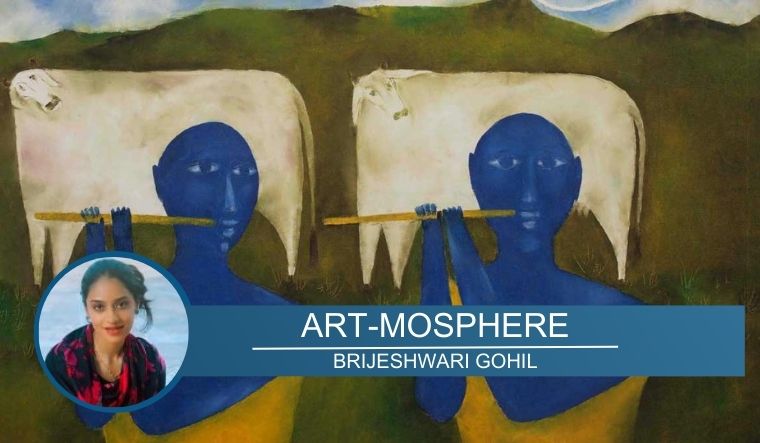Another long weekend commences as Janmashtami will be celebrated on Monday, August 26. The birth or 'janma' of Lord Krishna, the eighth child of Devaki is celebrated on the eighth day or 'ashtami' of the month of Bhadrapada (hindu calendar). Hindu mythology celebrates Krishna as the avatar of Vishnu, born to destroy the evil ruler of Mathura, Kansa and ally to the Pandavas. As an eternally fascinating Lord for his millions of devotees, Krishna has also always been a beloved muse for artists.
The tales of Krishna explore every human emotion, be it the innocence of a baby, the mischief of a child, the pure love of a mother and child, the passionate romance of lovers, the loyalty of a friendship and the supreme courage to be righteous. Revered as the God of compassion, love and protection, Krishna has been featured in art and architecture, beautiful panels and murals, stone and metal sculptures and famously, in delicate, intricate miniature paintings. Historically, Krishna’s art was a part of every Indian household, in some form or another.
The earliest paintings known to explore Krishna are the 2nd BCE rock paintings at Tikla near Gwalior, Madhya Pradesh. A short Brahmi inscription accompanies the painting created using red ochre pigment depicting three human figures. The first figure, a male, holding a halayudha or a plough-shaped weapon, a representation of Balarama, elder brother of Krishna. The second male figure can be identified as Vasudeva. Krishna is depicted with headgear that looks something like a solar disc. The third figure is a female identified as Ekanamsha, sister of Krishna and Balarama. Down the ages, Krishna has been depicted in countless ways, through a number of narratives and tales.
The birth of Shri Krishna was a dramatic night. One which artists love to explore for it provides the opportunity to not only narrate an important chapter of Hindu mythology but also allows the artist to explore colour, composition and a number of subjects. Raja Ravi Varma’s work narrates Vasudeva and Devaki escaping prison after the birth of Krishna. Part of the Maharaja Fateh Singh Museum in Vadodara, Gujarat, the artwork emotes the fear and caution with which they are leaving the prison, alert and watchful of their surroundings. The guard is seated, fast asleep. Viewing this art, one is curious, wanting to know how the story unveils. While Raja Ravi Varma stood as the pioneer in humanising Gods and Goddesses, the Thanjavur style of painting focused on simple compositions with embellished elements. Gold foil and elaborate gesso work would accentuate simple narratives. The style of painting, originating in the Tamil region of South India would often be seen on wooden panels in temples.
 Birth of Krishna, Raja Ravi Varma, Maharaja Fateh Singh Museum
Birth of Krishna, Raja Ravi Varma, Maharaja Fateh Singh Museum
Baby Krishna has been a popular theme in the Thanjavur style of painting. He embodies the innocence and playfulness of a child with a hint of mischief in these works. There is a sense of connect and an element of relatability with Baby Krishna, the lover of butter and milk. Perhaps this is why artists continue to be inspired by the subject.
Miniature paintings across various schools be it the Rajasthani miniatures or the Kangra miniatures have all elaborately explored the love of Radha and Krishna. Delicate works with vivid colours bring to life the romance of Radha Krishna. The baramasa (twelve months), a depiction of the seasons, the cyclical nature of time and the impermanence of life were a popular theme explored by miniature painting artists. They would often do this keeping Radha and Krishna as the protagonists. Natural colours would be painstakingly derived from dried flowers and herbs. Gold leaf would then be produced by continuously rubbing a Kansa bowl with local honey. Then, with a fine brush made from squirrel hair, the artists would create delicate, lyrical miniature works of art. These exquisite works would showcase the romance of Radha and Krishna through the twelve seasons. Enjoying the monsoon rains, sitting out the languid summer days or awaiting the blooming and blossoming of spring.
Krishna is the devotional centre for Rajasthan’s pichwai artists of Nathdwara, the Chola Bronzes of South India or the ivory and wooden panels, which illustrate important life’s learning lessons and sagas. Modern and contemporary artists too have used Krishna as their muse. The devotional subject sparks interest in not only the artist but also the art connoisseur. Manjit Bawa’s vibrant works of art challenge form and figure, creating his own distinct style. A work depicting Krishna by Manjit Bawa set against a lush, red backdrop sold for a whopping 25.11 crore in an auction last year. Similarly, the Prinseps Modern Art auction concluded earlier this week with a beautiful oil on canvas work depicting Krishna by Haku Shah, a well-known artist of the Baroda School. The work sold for twenty lakhs. Almost twenty times the estimated price.
I was impressed to see an exhibition at the Nita Mukesh Ambani Cultural Centre’s (NMACC) Art House in Mumbai do justice to the various chapters of Krishna’s life. Curator Ashvin Rajagopalan has successfully managed to bring to a single venue the many tales of Shri Krishna depicted through a number of mediums across decades.
But artists are not the only creatives bringing Lord Krishna to life. Indian classical music, beautiful soulful ragas, and kathak dance recitals enact Krishna as the butter thief, Krishna as the cow protector, and the love saga of Radha and Krishna. “Rajadhiraaj” is a musical on Krishna currently running at NMACC.
These are not only cultural performances and stunning works of art but also values and teachings on how to lead a life of ‘karma’ (deeds) and ‘dharma’ (duty).
Krishna’s lessons stand the test of time. Relatable to every generation, and inspirational to every artist.


